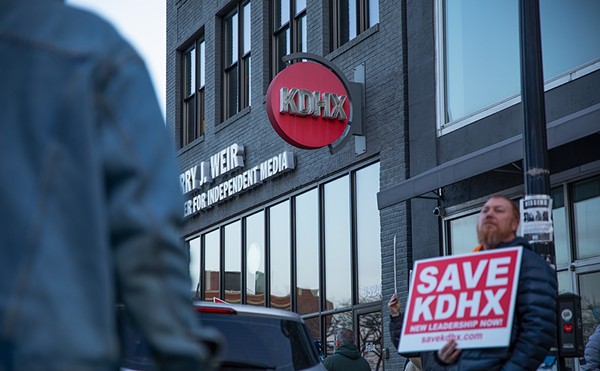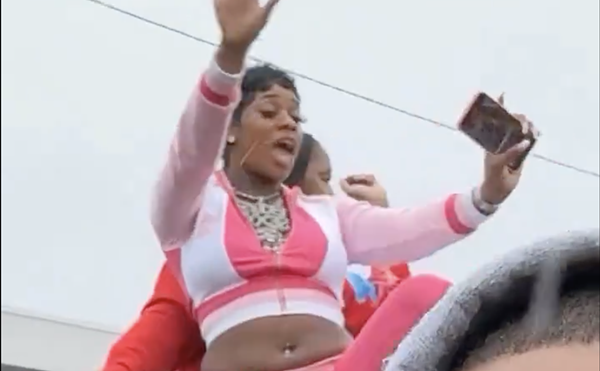Internal hemorrhaging, advanced cirrhosis of the liver, hep C — he should have died that night. But after two years of recuperation, the most original and influential songwriter and rocker from Austin, Texas, has returned with his most varied and demanding album, The Boxing Mirror (produced by long-time hero John Cale), and a full band tour. He took a break from lunch in downtown Austin to recount his resurrection.
B-Sides: St. Louis has been a longtime tour stop, but you haven't always done well here. At some early shows at Off Broadway, the audience was basically me, some KDHX DJs and a couple winos from down the street.
Alejandro Escovedo: I love St. Louis. It's got one of my favorite record stores anywhere. It's been constantly building. Some cities, like LA and New Orleans, have been difficult for me. But the constant touring paid off, even though there was a price to pay for it.
How is your stamina?
Better all the time. I'm almost completely there. I can't tour like I used to. But I don't really want to. It's my personal health.
How did you handle hep C at first?
Back in the '90s, there wasn't that much known about it. The interferon treatments were very difficult on the body, and I wasn't a good candidate. It was really expensive; I couldn't afford it. I tried the holistic route. One doctor wanted me to become a vegan, but I was touring, and it's hard to be a vegan in the Midwest. I tried my own path, the path of moderation, but it didn't work. I was oblivious to what I was doing. Two days after breaking down in Arizona, I was supposed to get on a plane to Europe to play festivals. If that had happened on the plane, we wouldn't be talking.
You met your wife (and poet) Kim Christoff in Arizona. What have you learned from working with her?
It's freed up my sense of what lyrics can be, what a song can be. Her imagery is so free. It's rubbed off on me, for the better. I was kinda looking for that. My songs tend to be a little more narrative and deal specifically with my life and family, so I write from a first-person view. I wanted to step away from myself and find other words, other subjects.
You've known John Cale since 1978, but what surprised you most about working with him as a producer?
How easy and comfortable it was. How much we laughed. He put me in a place where I felt very confident, which not every producer knows how to do. With John, it's not some theory he has; it's his presence. It requires that you step up a few notches, to just attain that same presence. When we were sitting across from each other, I wanted to be as strong as he was.
What was unique about his recording philosophy?
We started with voice, piano and guitar. We didn't start with rhythm tracks, which is how most records are made. But starting with voice, it establishes the emotional content of the song. The rhythm section has to dig what's happening lyrically. In my opinion, this is the best drumming that Hector [Muñoz] has ever done.
The Boxing Mirror doesn't sound like any record you've ever made, but it still sounds like an Alejandro record.
Some producers make records that sound like them. But I'd been such an admirer over the years, and emulated him, so it just end up being a good match. We spoke the same language. We wanted the same things from the album.
Do you still want the myth of rock & roll? Is that myth dead for you?
If you were to hang out with me, you'd hear me slag a lot of bands because they're not rock & roll enough. For me, though, it's not really about being in a rock band. For instance, we use strings. That's not very rock & roll. But we bring a certain placement and attitude and expression to them. Before, when I was a kid, if you didn't look rock & roll, I wouldn't think you were rock & roll. Now what's important is the experience you bring to it. — Roy Kasten
9 p.m. Thursday, August 17. Blueberry Hill's Duck Room, 6504 Delmar Boulevard, University City. $15. 314-727-4444.
Rap-a-Lot
If they ever again shoot a capsule into space containing artifacts designed to explain life on Earth to other worlds, they'll have to make room on board for all twelve volumes of Hip-Hop Essentials. It's hard to imagine a better explanation of hip-hop for an alien culture. Covering the years between 1979 — when "Rapper's Delight" introduced the new sound to much of the nation — until 1991, the year before the music went mainstream and never looked back, these 144 songs offer an unparalleled crash course in hip-hop history. Think of an important hip-hop track from this era, and chances are it's on one of these CDs.
"Anyone who doesn't have this in their collection, their collection isn't complete. And I don't mean hip-hop collection; I mean music collection," says Tom Silverman, founder of pioneering hip-hop label Tommy Boy and the force behind this compilation, which began appearing late last year. (The final volumes are now in stores.)
Forget explaining hip-hop to aliens. Silverman is faced with a tougher job: trying to explain it to today's young fans, who think "old school" means Nas, Jay-Z and Snoop. Silverman says he undertook the project after becoming concerned that the media aren't doing much to keep the record straight about hip-hop's origins. "I'd been really worried, because I'd been going to these VH1 Hip-Hop Presents events," Silverman says. "And it seems to me that they're rewriting hip-hop history in a different way than how it happened."
Each album features a cross-section of releases, so you'll find, for example, a number-one smash like Tone-Loc's "Wild Thing" alongside an obscure old-school classic, such as Masterdon Committee's 1982 single "Funk Box Party." The series features rare photos from hip-hop's past, and the liner notes are penned by music's top chroniclers: authors Nelson George, Jeff Chang, Greg Tate and Brian Coleman. Coleman's introduction to volume five rejects clichés about the kinder, gentler hip-hop of the old days.
"It's overdue," legendary DJ Red Alert says of the compilation. "If people would take time to listen to the hip-hop of the past, they'd see where hip-hop today comes from." — Dan LeRoy
St. Louis Scene Trading Cards
Name: Mario Viele and Maysam Attaran
Birthdates: October 24, 1982;
October 27, 1981
High School: Lafayette High School
Can Be Found: Running the record label Roadhouse Tunes. Maysam plays drums and Mario plays guitar for both the Sex Robots and the Pubes. The two also collaborated on the yet-to-be-released film Mulehorse!, which features music by local bands.
Career Highlights: Maysam is most proud of the newest Sex Robots record, while Mario cites touring with Bunnygrunt (one of his favorite bands) as the cherry on his sundae.
Fun Facts: Mario is a walking encyclopedia of Watergate factoids, while Maysam always wears sunglasses onstage to cope with his stage fright.





